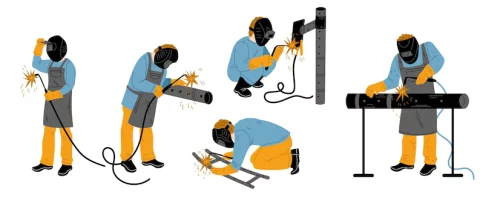Best Credit Cards USA
Are you in the market for the best credit cards USA has? Trying to find the best credit card in the USA can be daunting. This article is for you. Why are these the best credit cards? Discover the unique qualities of each of these credit cards.
Sponsored Listings

How Do Credit Cards Function?
Using your credit card, you are borrowing money on a short-term basis from the line of credit your card issuer provided. Your line of credit is reduced by the amount you borrow. Your monthly bill payment replenishes your available credit and establishes your creditworthiness.
You will only be responsible for paying interest if you make your complete payment on time. If you don’t, interest will be applied to the unpaid portion of your balance. Remember that your credit limit is no longer accessible if you carry a balance. For instance, if your credit limit is $2,000, but you still owe $500, your available credit is only $1,500.[1]
Carrying multiple credit cards could be advantageous if you know how to manage your credit well. You can maximize rewards and benefits and establish a solid credit history by having several cards in various categories. Your spending patterns and capacity to make payments on time will determine whether you have too many credit cards.
Obtaining a Credit Card: How to Apply For the Best Credit Card in USA
The fundamental stages to applying for a credit card online are as follows:
1. Find out what your credit score is.
Free credit ratings are available from many sources, including your bank or the statement for your credit card. Make sure to target credit cards that you can get approved for, given your credit score. A card that requires you to pay off outstanding credit will not be accepted.
2. Finish completing the form.
You will need to provide your name, social security number, birth date, mailing address, e-mail address, and other identifying information. You must also include your employer and yearly income. This information aids the issuer in determining whether you have a stable job and sufficient income to cover any credit card balances you accrue.
3. The issuer will examine your credit report and credit score.
Your credit report summarizes your payment history, current accounts, debt, and any disturbing records that may appear on your report, such as a delinquent account. You submit these along with your credit card application. Another tool to assess if your application should be authorized is your credit score, which also represents your creditworthiness.
4. Attend to the outcome of your application.
If approved, you’ll get your new credit card in about ten business days. When you receive the card, you can activate it by contacting the given number or going online.
If your application is rejected, you will have to take the next step. Credit denial may occur for a variety of reasons. For instance, you might have excessive credit report inquiries, a poor credit score, or insufficient income.
You can learn important information about what you need to do to improve your chances of approval from the adverse action letter. Call the reconsideration line provided by the issuer if you feel the need to talk about the situation. The adverse action letter frequently includes this number. If not, call the customer service number and ask to be put in touch with the department that handles credit card reconsiderations.[2] Be ready to discuss the issues mentioned in the letter before you make the call.
Best Secured Credit Card USA
Credit card firms provide many types of cards to satisfy various customer needs. Some people load much money onto their cards each month, pay them off immediately, and profit from having a card that rewards them for some of their purchases. Others frequently carry a balance from month to month; for these people, a card with a low ongoing interest rate is better. Others are striving to build their credit; issuers also offer cards for those individuals. The best credit card for you depends on your unique needs at each moment.
Here are popular names:
- Altitude® Connect Visa Signature® Card from U.S. Bank
- Freedom Unlimited by Chase
- American Express Delta SkyMiles Gold Card
- American Express Blue Delta SkyMiles Card
- Transfer Discover it® Balance
- Reflect® Card from Wells Fargo
- Student Cash Back from Discover
- Chrome Discover it® Student
- Cash Back from Discover it
- American Express Blue Cash Preferred® Card
- Card from Chase Freedom® for students
- Mastercard® Secured by Citi
- American Express’s Blue Cash Everyday® Card
Basics Of Credit Cards For Novices: Types Of Credit
Choosing a credit card can be extremely daunting. Issuers provide a wide range of options and benefits that you can obtain.
The several credit card categories that you should be aware of are summarized below:
Credit Cards For Students
One of these college student-targeted credit cards can be a fantastic option as your very first credit card. Numerous student credit cards come with perks like cash-back rebates, prizes for good grades, and free credit reports. The Credit CARD Act of 2009 stipulates that cardholders must be at least 21 years old or provide evidence of sufficient income.
Bad Credit Cards
Credit card issuers view you as hazardous if your FICO score is below 580. People with credit scores in this range frequently cannot obtain conventional credit cards. Even though many of these cards have fees and high APRs, you can be eligible for unsecured credit cards if you have bad credit. To learn how much you might have to pay to use a card, thoroughly read the tiny print.
Credit Cards With Security.
These credit cards are a helpful tool for building or rebuilding credit. Cash deposits are required for secured cards, and they are typically between $200 and $2,500. However, some issuers permit more enormous deposits for people who seek a higher credit limit. Your deposit lowers the lender’s risk, but you’re still making purchases on credit. When you close your account or convert to an unsecured account, you receive your deposit back if there is no outstanding balance.
Cards For Balance Transfers.
Getting a balance transfer credit card can help you save money on interest if you have credit card debt but still have decent credit. The best credit cards have a 0% introductory APR for a set amount of time, usually between 15 and 21 months. Credit cards with balance transfers frequently have a transfer fee, typically between 3% and 5% of the total transferred.
Credit Cards With Rewards
With these credit cards, users can accrue points or miles that can be exchanged for various benefits, such as cash-back, travel, and merchandise. Multiple redemption options provide you flexibility, and some award extra points for spending in bonus areas like petrol, eating, or vacation.
Credit Cards With Cash-Back.
These cards give cash-back benefits in various categories, which can help you save money on daily purchases. For each type, you frequently receive a varied reward rate. You might receive 3% cash back on supermarket purchases, 2% at gas stations, and 1% on all other forms of shopping, for instance. Some cash-back cards contain cyclical changing categories.
Credit Cards With Travel Benefits.
Within this category are several different credit card kinds, including general travel rewards cards with flexible possibilities and airline and hotel branding cards. You’ll discover that the rewards and benefits offered by each card vary.

How Credit Card Bonuses And Rewards Operate With The Best Credit Cards In USA
Every dollar you spend with a rewards credit card might earn you points, miles, or cash back.[3] You can redeem rewards from your card in various ways, regardless of whether they are designated as points, miles, or cash back. Depending on your card, you can exchange points for items, cash back, travel, or other choices. If you don’t carry a balance on your rewards card, it might be an excellent method to make money from your purchases.
Most reward cards offer a sign-up incentive to encourage new users. If you use the card for a specific amount, typically within the first few months after creating your account, you can earn a sign-up bonus, which is frequently worth hundreds of dollars.
Selecting Your Best Credit Card
Several factors determine which cards you are eligible for and the guidelines you should apply:
Your Credit Report
You have a better chance of being approved for the finest cards the higher your credit score. Credit scores are accessible for free on NerdWallet.
Select A General Card Kind
Get a card intended for establishing or repairing credit if your credit rating requires improvement. Otherwise, decide between a card that would reward you for your purchases and one that will help you avoid paying interest.
Limit Your Options.
Do you prefer cash back or points if you want a rewards card, and how much work are you ready to put into managing your rewards?
When comparing the best credit cards USA, focus on the following factors:
- Annual cost
- Fee for balance transfers.
- Foreign exchange charge.
- Fee for cash advances.
- Late fines and payment-return fees.
- Perks
- Credits on statements.
- Purchase safeguards.
- Additional warranties.
- Credit monitoring and protection.
- No cost credit score.
- Services for credit monitoring.
- Your card’s “lock” ability.
Conclusion
Knowing the various categories of businesses in the sector can be helpful as you look for the best credit cards usa for your requirements. In this manner, you will know what to look for and where to look for a credit card. Be sure to consider the perks of each card carefully before making your final decision for the best credit cards in USA.
Sponsored Listings
Reference
[1] The Importance of Having Available Credit “Why Your Credit Card’s Available Credit Is Important” Dotdash Meredith, 2021
[2] Why Did I Receive an Adverse Action Notice? “What Is an Adverse Action Letter?” Experian, 2020
[3] Cash back “Cash Back vs. Travel: How to Choose Credit Card Rewards” NerdWallet, 2022





